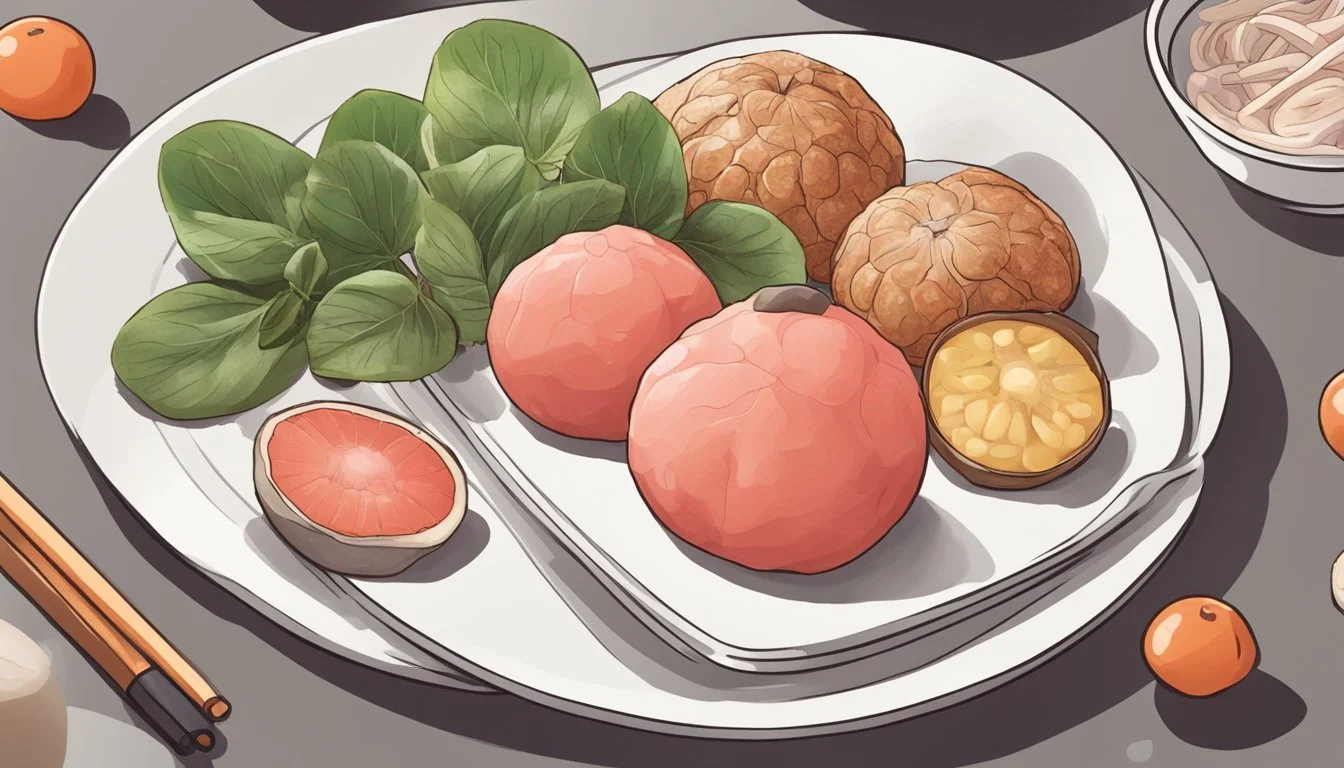Can Diabetics Eat Umeboshi?
Exploring Health Impacts
For people managing diabetes, dietary choices play a critical role in maintaining blood sugar levels. Umeboshi, a traditional Japanese pickled plum, is known for its robust flavor and numerous health benefits. This salty and sour delicacy is packed with organic acids and polyphenols, which can be beneficial for overall health.
Umeboshi can be a nutritious option for diabetics when consumed in moderation. The high content of citric acid and polyphenols in umeboshi may help in regulating blood sugar levels and improving metabolic health. Moreover, its strong, tangy taste can enhance the flavor of dishes without the need for additional sugar or unhealthy additives.
It's important to note that umeboshi is quite high in sodium, and overconsumption may not be advisable for everyone, particularly those with high blood pressure. Yet, when included thoughtfully in a balanced diet, this small yet powerful fruit can offer a flavorful boost along with potential health benefits for diabetics.
Understanding Umeboshi
Umeboshi, or Japanese pickled plums, have a rich history and are revered in Japanese cuisine. They are prized for their unique taste, health benefits, and preservative qualities. This section explores their historical significance and the intricate production process.
Historical Significance
Ume, often referred to as "plum" despite being more closely related to apricots, has been a staple in Japanese culture for centuries. Umeboshi was traditionally used as a preservative and medicinal food. Samurai carried them during wars for their stamina-boosting and antiseptic properties.
In Japanese households, umeboshi were a common sight in bento boxes and onigiri. They were also associated with longevity and health.
Production and Types
Producing umeboshi involves several steps. Fresh ume fruits are harvested, then pickled with salt and red shiso leaves. The mixture is left to ferment for several weeks. Salt not only preserves the fruit but enhances its sour flavor.
There are different types of umeboshi, varying in sourness and saltiness. Some are sweetened or flavored with honey. The most traditional ones remain extremely salty and sour.
Different regions in Japan offer their own variations of umeboshi. Despite these variations, the basic method of salting and fermenting remains consistent across the country.
Nutritional Profile of Umeboshi
Umeboshi, also known as pickled plums, are nutritious foods that contain essential macronutrients, vitamins, and minerals. This fermented fruit offers a unique combination of beneficial compounds that are particularly relevant for dietary considerations.
Macronutrients and Calories
Umeboshi is a low-calorie food, making it an appealing choice for those monitoring their caloric intake. A serving of approximately 100 grams contains only about 33 calories. Despite its low calorie content, umeboshi offers a modest amount of macronutrients.
Protein: Around 1 gram per 100 grams of umeboshi.
Fat: Essentially 0 grams, making it a fat-free option.
Carbohydrates: Contains about 10 grams, with 3.4 grams attributed to dietary fiber.
This composition is beneficial for those looking to manage their weight or blood sugar levels, as the fiber content aids in digestion and helps maintain stable blood sugar levels.
Minerals and Vitamins
Umeboshi is rich in minerals and vitamins that contribute to various health benefits. Among the key minerals, potassium and sodium are prominent. Potassium is essential for heart health and muscle function, while sodium, although present, should be consumed in moderation due to umeboshi's high salt content.
Citric Acid: High levels of citric acid help in digestion and improve nutrient absorption.
Polyphenols: These compounds have antioxidant properties, notably the "ume lignans," which contribute to reducing the risk of chronic diseases.
Vitamins: While specific vitamin content can vary, umeboshi generally contains several B vitamins and small amounts of vitamins A and E.
This combination of nutrients not only supports overall health but also provides essential antioxidants and minerals that are crucial for maintaining bodily functions.
Health Impacts of Umeboshi
Umeboshi has been consumed for centuries in Japan and is known for its potential health benefits, including aiding digestion, providing antioxidant properties, and influencing heart health.
Digestive Benefits
Umeboshi is beneficial for digestive health. Rich in dietary fiber, it helps regulate bowel movements and aids in preventing constipation. Studies indicate that umeboshi can improve gastric motility, which helps in moving food through the stomach more efficiently.
Its alkaline nature can help neutralize stomach acids, providing relief from acid reflux. Some research shows that daily consumption of umeboshi may significantly reduce symptoms of acid reflux and other digestive complaints. For those managing their digestive health, incorporating umeboshi can offer substantial benefits.
Potential Antioxidant Effects
Umeboshi contains various vitamins, minerals, and antioxidants. These antioxidants help combat oxidative stress and free radicals in the body. The presence of compounds like polyphenols can protect cells from damage, potentially reducing the risk of chronic diseases, including cancer.
Considering its nutritional profile, umeboshi offers a low-calorie option rich in micronutrients that can support overall health. Regular consumption may contribute to better protection against cell damage and support the liver in optimizing its detoxification processes.
Impact on Blood Pressure and Heart Disease
Umeboshi may positively impact blood pressure and heart disease. Its high potassium content helps regulate blood pressure by balancing sodium levels in the body. Consuming umeboshi can be beneficial for heart health by reducing the strain on blood vessels.
The antioxidants present in umeboshi also play a role in minimizing inflammation. Reduced inflammation can lower the risk of developing heart disease. Through its nutrient-rich profile and anti-inflammatory properties, umeboshi can be an excellent addition to a heart-healthy diet.
Umeboshi in a Diabetic Diet
Incorporating umeboshi into a diabetic diet can offer specific benefits, like aiding in blood sugar management and supporting weight control efforts. This section explores these aspects in detail.
Blood Sugar Management
Umeboshi, known for its potent and tangy flavor, has a negligible impact on blood sugar levels. This makes it a potentially safe choice for individuals with diabetes. Umeboshi's low glycemic index (GI) means it causes a slower release of glucose into the bloodstream. This helps prevent spikes in blood sugar.
Additionally, umeboshi is rich in antioxidants, which may help improve overall cellular health—a key concern for those managing diabetes. These antioxidants can support better insulin sensitivity.
Incorporating umeboshi into meals can be as simple as adding small pieces to salads, rice dishes, or using it as a seasoning. Care should be taken, though, due to its high salt content.
Weight Control Considerations
Weight management is crucial for those living with Type 2 diabetes. Umeboshi can be a useful addition due to its low calorie content. When incorporated in small amounts, it can enhance the flavor of meals without adding significant calories.
The strong taste of umeboshi may help reduce the need for additional high-calorie condiments. This can be particularly beneficial in low-calorie diets. Its high sodium content, however, necessitates moderation to avoid excessive salt intake.
For those focusing on weight control while managing diabetes, umeboshi's role should be part of a balanced diet. Pairing it with fresh vegetables and lean proteins can create satisfying and nutritious meals.
Culinary Uses of Umeboshi
Umeboshi, a traditional Japanese ingredient, enhances dishes with its unique salty and sour flavor. It is used in both classic Japanese cuisine and modern culinary creations.
Traditional Pairings and Dishes
Umeboshi is commonly found in rice balls (onigiri) and various fukiage mixes. The pickled plum is typically placed at the center of the rice ball, adding a burst of flavor. Another common dish is chazuke (or ochazuke), where umeboshi is placed on top of a bowl of rice with hot green tea poured over it.
Fish and vegetables often incorporate umeboshi in traditional Japanese meals. For instance, it adds a distinct tang to grilled fish and steamed vegetables. Additionally, it can be used to enhance miso soup, offering a subtle tartness that balances the savoriness of the soup.
Modern Adaptations and Recipes
In contemporary cooking, umeboshi has found its way into a variety of dishes. Umeboshi paste is a versatile ingredient used in salads, pasta, and as a seasoning for sauces and salad dressings. Blending the paste with ingredients like ginger, garlic, and soy sauce creates flavorful marinades for tofu and tempeh.
Umeboshi vinegar, derived from the pickling process, is popular in making pickles and can also give a unique twist to various dishes. Incorporating umeboshi into modern diets has expanded its culinary applications, making it a staple ingredient in both traditional and innovative recipes.
Safe Consumption Tips
For diabetics considering umeboshi, it's important to be mindful of portion sizes and potential interactions with medications to ensure safe consumption.
Portion Sizes and Frequency
Due to the high sodium content in umeboshi, it is crucial for diabetics to limit their intake. A single umeboshi plum can contain significant amounts of salt, which can affect blood pressure and overall sodium levels.
Recommended Portion:
1-2 plums per serving
No more than 2-3 times per week
These limits can help manage both sodium intake and glycemic control. Umeboshi is low in calories but should not be consumed in large quantities due to the concentrated salt content.
Interactions with Medications
Diabetics often take medications that can be affected by high sodium levels. For instance, blood pressure medication and diuretics can interact negatively with the salt content in umeboshi.
Medications affected by high sodium:
Blood pressure medication
Diuretics
Certain diabetes medicines
It is essential to consult a healthcare provider before incorporating umeboshi into a diabetic diet. They can offer personalized advice on how much umeboshi is safe to consume based on individual health needs. Regular monitoring of blood pressure and blood sugar levels is also recommended.
Alternatives to Umeboshi
Alternative options to Umeboshi can be found in other pickled fruits and vegetables, as well as snacks that cater to low-sodium and diabetic-friendly needs. Many of these alternatives provide delicious and healthy options suitable for different dietary restrictions.
Other Pickled Fruits and Vegetables
For those seeking alternatives to Umeboshi, various other pickled fruits and vegetables can offer similar tangy flavors while enhancing your diet. Pickled cucumbers, commonly known as pickles, are a popular choice and are available in low-sodium versions. Kimchi, a traditional Korean staple, is a spicy fermented cabbage rich in probiotics and vitamins A and C.
Pickled carrots and radishes are also great options. These vegetables maintain their crunchiness and can be seasoned with vinegar and mild spices to create a diabetic-friendly snack. Another valuable option is sauerkraut, a fermented cabbage known for its low calorie and high probiotic content, aiding in digestion.
Low-Sodium and Diabetic-Friendly Snacks
Snacks suited for diabetics and those monitoring their sodium intake can be nutritious and satisfying. Fresh fruits like apples, berries, and pears are naturally low in sodium and high in fiber. Vegetable sticks made from cucumbers, bell peppers, and carrots paired with hummus provide a filling, low-sodium snack packed with nutrients.
Nuts and seeds like almonds, walnuts, and sunflower seeds are excellent for quick bites. They offer healthy fats and protein. For those who enjoy savory flavors, air-popped popcorn seasoned with herbs can be a tasty, guilt-free option. Edamame, or boiled green soybeans, also make a flavorful snack rich in protein and low in carbohydrates.









